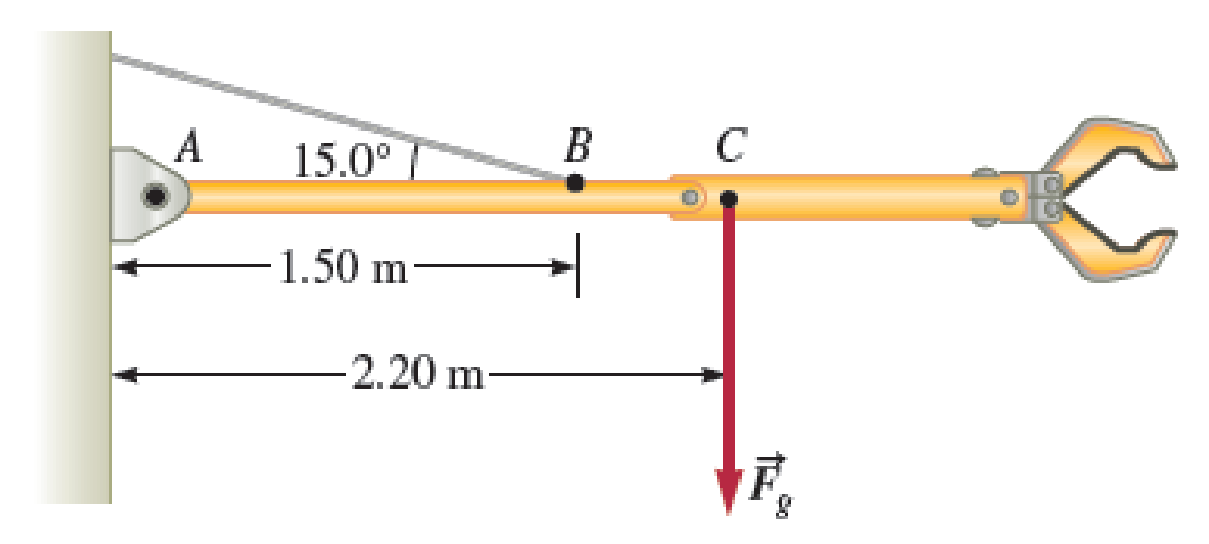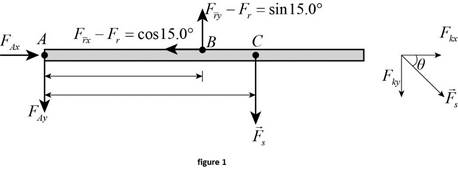
Concept explainers
A 215-kg robotic arm at an assembly plant is extended horizontally (Fig. P14.32). The massless support rope attached at point B makes an angle of 15.0° with the horizontal, and the center of mass of the arm is at point C. a. What is the tension in the support rope? b. What are the magnitude and direction of the force exerted by the hinge A on the robotic arm to keep the arm in the horizontal position?

FIGURE P14.32
(a)
Tension in the support rope.
Answer to Problem 32PQ
The tension in the support rope is
Explanation of Solution
The figure given below is the free body diagram of the robotic arm.

In the equilibrium state of the system, the net torque experienced by the robotic arm is zero. Take shoulder joint at point A as the pivot point. The forces acting on the body are the force of tension on the rope and the force at robotic arm due to gravitational field. Torque acts on the arm due to these forces.
Write the equation to find the torque produced by the tension on the rope.
Here,
Write the equation to find the torque acting on the arm due to earth’s gravity.
Here,
Write the equation to find the gravitational force.
Substitute the above equation in (II) to get
The force of gravity is in down ward direction, therefore the torque due to gravitational force has a negative sign.
Add equations (III) and (I) to find the sum of torques at the arm.
Since the sum of torque is zero in equilibrium condition, equate equation (IV) to zero and solve for
Conclusion:
Substitute
Therefore, the tension in the support rope is
(b)
The magnitude and direction of force exerted by hinge
Answer to Problem 32PQ
The magnitude of the force exerted by hinge
Explanation of Solution
At equilibrium the sum of both x and y components of all the force is equal to zero.
The forces in the y direction are the force exerted by the hinge, force due to the tension on rope, and the force due to gravity.
Write the equation to find the y component of force due tension on the rope.
Here,
Write the equation to find the force due to gravity.
Add equation (VI) and (VII) to get the sum of forces.
In addition to these two forces there is the force exerted by the hinge on the arm of the robot. Let this force be
Add
Here,
At equilibrium, the sum of y component of forces is equal to zero. Equate equation (VIII) to zero and solve for
Substitute equation (V) in (IX) and solve for
The forces acting in the x direction are the force due to tension on rope and the horizontal component of force exerted by the hinge.
Write the equation to find the x component of the tension force on the rope.
Here,
Substitute equation (V) in (XI).
Write the equation to find the sum of forces in the x direction.
Here,
Substitute equation (XII) to the above equation to get
In equilibrium, sum of forces in the x direction is zero. Equate equation (XIII) to zero.
Solve equation (XIV) to get
Write the equation to find the resultant force exerted by hinge.
Here,
Write the equation to find the angle made by the resultant force with the horizontal.
Here,
Conclusion:
Substitute
Substitute
Substitute
Substitute
Therefore, the magnitude of the force exerted by hinge on arm is
Want to see more full solutions like this?
Chapter 14 Solutions
Physics for Scientists and Engineers: Foundations and Connections
- 1.62 On a training flight, a Figure P1.62 student pilot flies from Lincoln, Nebraska, to Clarinda, Iowa, next to St. Joseph, Missouri, and then to Manhattan, Kansas (Fig. P1.62). The directions are shown relative to north: 0° is north, 90° is east, 180° is south, and 270° is west. Use the method of components to find (a) the distance she has to fly from Manhattan to get back to Lincoln, and (b) the direction (relative to north) she must fly to get there. Illustrate your solutions with a vector diagram. IOWA 147 km Lincoln 85° Clarinda 106 km 167° St. Joseph NEBRASKA Manhattan 166 km 235° S KANSAS MISSOURIarrow_forwardPlz no chatgpt pls will upvotearrow_forward3.19 • Win the Prize. In a carnival booth, you can win a stuffed gi- raffe if you toss a quarter into a small dish. The dish is on a shelf above the point where the quarter leaves your hand and is a horizontal dis- tance of 2.1 m from this point (Fig. E3.19). If you toss the coin with a velocity of 6.4 m/s at an angle of 60° above the horizontal, the coin will land in the dish. Ignore air resistance. (a) What is the height of the shelf above the point where the quarter leaves your hand? (b) What is the vertical component of the velocity of the quarter just before it lands in the dish? Figure E3.19 6.4 m/s 2.1arrow_forward
- Can someone help me answer this thank you.arrow_forward1.21 A postal employee drives a delivery truck along the route shown in Fig. E1.21. Determine the magnitude and direction of the resultant displacement by drawing a scale diagram. (See also Exercise 1.28 for a different approach.) Figure E1.21 START 2.6 km 4.0 km 3.1 km STOParrow_forwardhelp because i am so lost and it should look something like the picturearrow_forward
- 3.31 A Ferris wheel with radius Figure E3.31 14.0 m is turning about a horizontal axis through its center (Fig. E3.31). The linear speed of a passenger on the rim is constant and equal to 6.00 m/s. What are the magnitude and direction of the passenger's acceleration as she passes through (a) the lowest point in her circular motion and (b) the high- est point in her circular motion? (c) How much time does it take the Ferris wheel to make one revolution?arrow_forward1.56 ⚫. Three horizontal ropes pull on a large stone stuck in the ground, producing the vector forces A, B, and C shown in Fig. P1.56. Find the magnitude and direction of a fourth force on the stone that will make the vector sum of the four forces zero. Figure P1.56 B(80.0 N) 30.0 A (100.0 N) 53.0° C (40.0 N) 30.0°arrow_forward1.39 Given two vectors A = -2.00 +3.00 +4.00 and B=3.00 +1.00 -3.00k. (a) find the magnitude of each vector; (b) use unit vectors to write an expression for the vector difference A - B; and (c) find the magnitude of the vector difference A - B. Is this the same as the magnitude of B - Ä? Explain.arrow_forward
 Physics for Scientists and Engineers: Foundations...PhysicsISBN:9781133939146Author:Katz, Debora M.Publisher:Cengage Learning
Physics for Scientists and Engineers: Foundations...PhysicsISBN:9781133939146Author:Katz, Debora M.Publisher:Cengage Learning College PhysicsPhysicsISBN:9781305952300Author:Raymond A. Serway, Chris VuillePublisher:Cengage Learning
College PhysicsPhysicsISBN:9781305952300Author:Raymond A. Serway, Chris VuillePublisher:Cengage Learning Physics for Scientists and EngineersPhysicsISBN:9781337553278Author:Raymond A. Serway, John W. JewettPublisher:Cengage Learning
Physics for Scientists and EngineersPhysicsISBN:9781337553278Author:Raymond A. Serway, John W. JewettPublisher:Cengage Learning Physics for Scientists and Engineers with Modern ...PhysicsISBN:9781337553292Author:Raymond A. Serway, John W. JewettPublisher:Cengage Learning
Physics for Scientists and Engineers with Modern ...PhysicsISBN:9781337553292Author:Raymond A. Serway, John W. JewettPublisher:Cengage Learning College PhysicsPhysicsISBN:9781285737027Author:Raymond A. Serway, Chris VuillePublisher:Cengage Learning
College PhysicsPhysicsISBN:9781285737027Author:Raymond A. Serway, Chris VuillePublisher:Cengage Learning University Physics Volume 1PhysicsISBN:9781938168277Author:William Moebs, Samuel J. Ling, Jeff SannyPublisher:OpenStax - Rice University
University Physics Volume 1PhysicsISBN:9781938168277Author:William Moebs, Samuel J. Ling, Jeff SannyPublisher:OpenStax - Rice University





